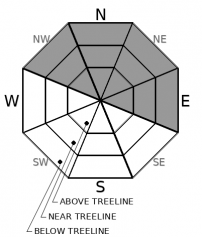| Saturday | Saturday Night | Sunday | |
|---|---|---|---|
| Weather: | Mostly cloudy then becoming partly cloudy. Snow levels below 7000 feet. Chance of precipitation is 0%. | Clear. Snow levels below 7000 feet. Chance of precipitation is 0%. | Sunny. Snow levels below 7000 feet. Chance of precipitation is 0%. |
| Temperatures: | 34 to 39. deg. F. | 17 to 23. deg. F. | 31 to 37. deg. F. |
| Mid Slope Winds: | East around 10 mph. | East around 10 mph. | East around 10 mph. |
| Expected snowfall: | No accumulation. | SWE = none. | No accumulation. | SWE = none. | No accumulation. | SWE = none. |
| Saturday | Saturday Night | Sunday | |
|---|---|---|---|
| Weather: | Mostly cloudy then becoming partly cloudy. Snow levels below 7000 feet. Chance of precipitation is 0%. | Clear. Snow levels below 7000 feet. Chance of precipitation is 0%. | Sunny. Snow levels below 7000 feet. Chance of precipitation is 5%. |
| Temperatures: | 31 to 37. deg. F. | 15 to 20. deg. F. | 28 to 34. deg. F. |
| Ridge Top Winds: | East 10 to 20 mph. | East 15 to 25 mph. Gusts up to 30 mph increasing to 40 mph after midnight. | Southeast 15 to 25 mph with gusts to 35 mph. |
| Expected snowfall: | No accumulation. | SWE = none. | No accumulation. | SWE = none. | No accumulation. | SWE = none. |
























